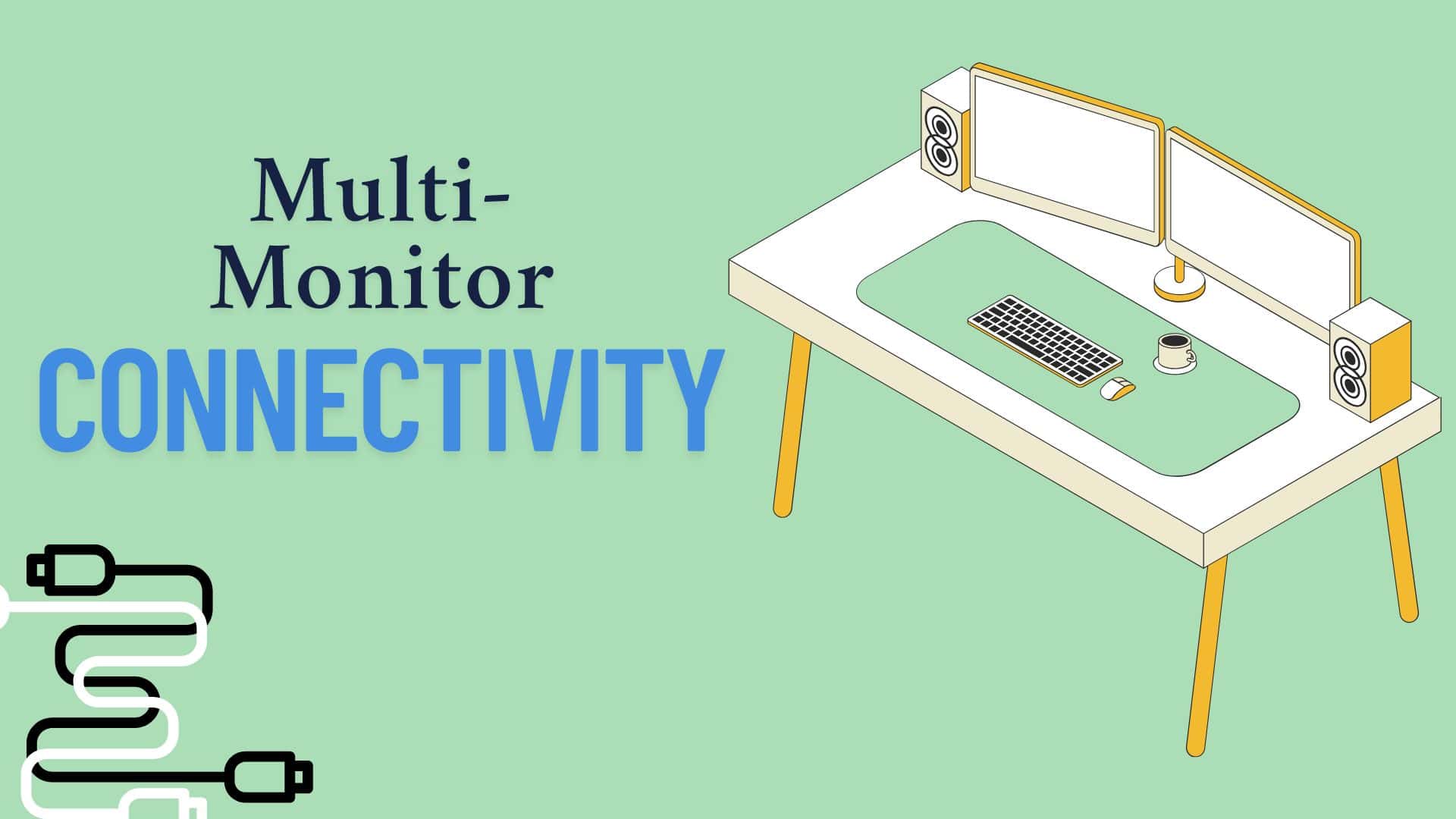Connecting your external monitors may seem like a straightforward process, but it isn’t always as easy as it looks and can be frustrating, especially if you’re setting up more than one monitor. How do you know which cords to use? Monitors offer different connectivity options, as does your laptop, so you need a cable that can connect to each port correctly and transmit high-quality audio/visual content. Let’s break down how you would connect to more than one external monitor with different types of cables.
General Tips
Before getting started with your cables, there are a few things to keep in mind when creating your setup. It’s helpful to have two or three of the same monitor, so you know they have the same connectivity options, but most monitors offer DisplayPort and HDMI connections. Check the refresh rate, color settings, and brightness settings to make sure you can match across screens, and determine how you’ll have audio output. You can Daisy-Chain your monitors or utilize a USB Hub, but both of those require the monitors to support this transmission. Each of these connection options we discuss supports USB Hubs and Daisy-Chaining, and can transmit 1080p up to 4K content.
HDMI Options
HDMI is the most commonly used connection option when connecting to external devices (monitors, TVs, and projectors) because it is almost always available on your device. Despite laptops getting skinnier, HDMI ports are usually available and can transmit high-quality video/audio content. While it’s easy to connect to one external monitor with a direct HDMI connection, once you add a second or third, you’ll have to see which way works with your devices. You can:
- Connect one cable to each monitor from your device (if your device has multiple HDMI ports).
- Connect the HDMI cables to a USB Hub that connects to your device.
- Connect one monitor to your device and then connect it to the second monitor using HDMI (if both monitors support this transmission).
Once you’ve determined if you’re going to connect your external monitors using HDMI, make sure you get the best cables available. Some monitors come with HDMI cables, but you’ll want to make sure you can transmit high-quality content, whether you’re using your monitors for graphic design, streaming, video games, or general use. Here are some great options for HDMI cables with high-quality content compatibility and different size ranges.
DisplayPort Options
While HDMI is a widely used option, many monitors need a DisplayPort cable if you plan to daisy-chain them together. Since this is their most common use, the majority of DisplayPort cables can easily transfer audio/visual content across screens and maintain quality levels. You can string several monitors together as long as one is connected directly to your laptop or device. Not many, if any these days, laptops offer DP ports, though, so here are some options on how to connect everything together. You can:
- Connect the DisplayPort cables to a USB Hub that connects to your device.
- Connect one cable to your device and then connect the rest of the monitors together using DisplayPort cables for daisy-chaining.
Once you’ve determined if you’re going to connect your external monitors using DisplayPort, make sure you get the right amount of cables needed. Some monitors come with DisplayPort cables, but you’ll want to make sure you can transmit high-quality content, whether you’re using your monitors for graphic design, streaming, video games, or general use. Here are some great options for DisplayPort cables with high-quality content compatibility and different size ranges.
Thunderbolt & USB-C Options
While most laptops offer HDMI or DisplayPort compatibility, certain brands exclusively use USB-C or Thunderbolt connections. This may limit your ability to connect to more than one external monitor, so you’ll want to make sure your laptop is compatible before buying a multi-monitor setup. Most monitors don’t need Thunderbolt or USB-C to connect to each other, but if you’re running them directly to your laptop, you’ll need those cords for compatibility. A USB Hub is also an option to avoid having to worry about mixing up cables and ensuring everything is connected correctly.
Below are some options for USB-C and Thunderbolt cords. They are mostly cross-compatible, so as long as you get a high-quality one, you don’t have to worry.
Troubleshooting Tips
If you’ve connected your monitors but they’re all displaying the same screen, go into Settings > System > Display > Select “Extend this Display” and save those settings. Now you should have a different screen on each monitor, and you can identify which is number 1, 2, 3, etc. to set up the order they’re in.
If you’re not seeing anything on one of the monitors, make sure the cable is connected to a “Display In” port (if applicable) or connect it directly to the device to ensure the cable and the monitor work.
Each monitor needs to be plugged into power directly; they will not be powered through your device, and your device will not be charged through your monitors.
Test everything before finalizing your setup to avoid having to redo connections!







![VESA Certified DisplayPort Cable, iVANKY 6.6ft DP Cable 1.2, [4K@60Hz, 2K@165Hz, 2K@144Hz], High Speed Gold-Plated Display Port to Display Port Cable, for Gaming Monitor, Graphics Card, TV, PC, Laptop](https://m.media-amazon.com/images/I/41TxNDSSowL._SL160_.jpg)
![Silkland USB 4 Cable for Thunderbolt 4 Cable 4FT, 40Gbps Data Sync, 8K/6K@60Hz, 240W Charging, [USB-IF Certified] USB C to USB C Thunderbolt Cable, Compatible for MacBook, SSD, Docking, iPhone 16,eGPU](https://m.media-amazon.com/images/I/41mXccKGFWL._SL160_.jpg)
![Cable Matters [Intel Certified] 40Gbps Thunderbolt 4 Cable 3.3ft with 8K Video and 240W Charging - 1m, Compatible with USB4, Thunderbolt 3 Cable and USB-C](https://m.media-amazon.com/images/I/41lpiJCsNCL._SL160_.jpg)
